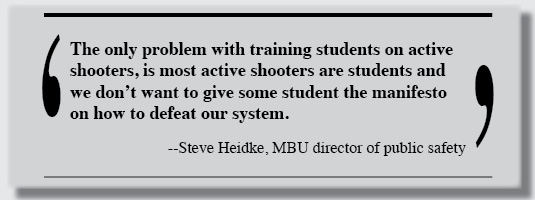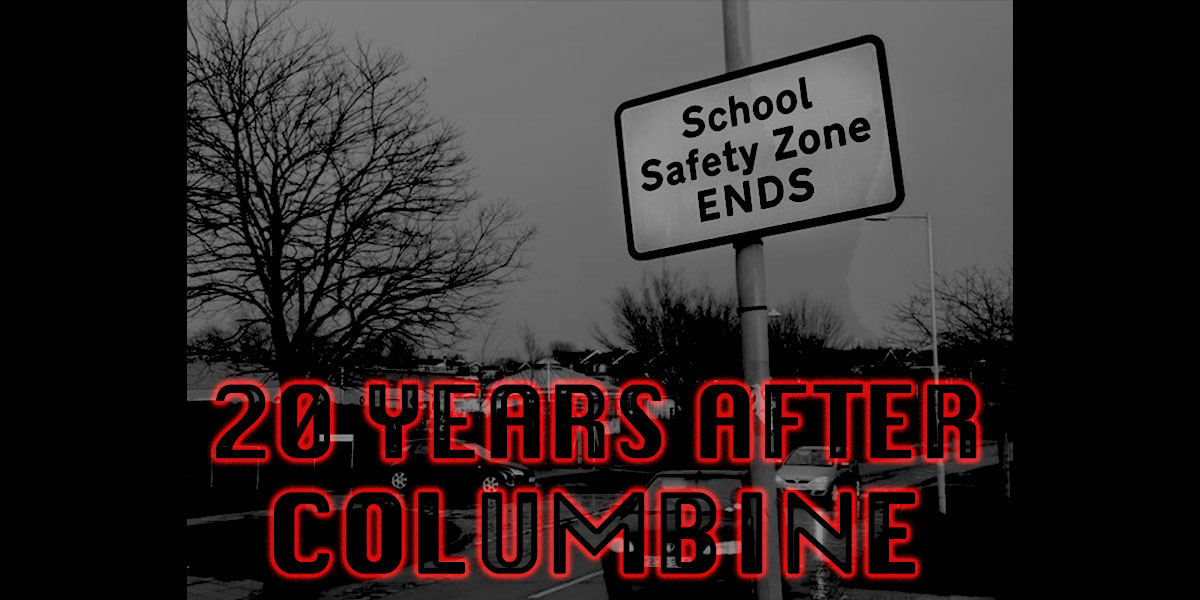— Part 4 of an 8-Part Series —
To ensure that students have the best chance of surviving an active shooter situation, several government entities such as the Department of Homeland Security and FEMA have provided training resources and information to students.
While faculty and staff members had the opportunity to prepare for these emergency situations at the In-Service Training Day on Feb. 20, students at MBU have received little information or training for such situations. And, according to Steve Heidke, director of public safety at MBU, this is by design. “The only problem with training students on active shooters, is most active shooters are students and we don’t want to give some student the manifesto on how to defeat our system,” Heidke said. Public Safety shares limited information and procedures with students “to prevent students who may revolt,” according to Heidke. MBU Public Safety has an “Active Shooter Awareness” video on MBU’s website that provides valuable information to MBU students. James Kellogg, director of the Criminal Justice Department and associate professor of criminal justice, listed several strategies MBU has employed to improve people’s chances in an active shooter situation: developing an emergency plan, developing a crisis communication plan, training staff, conducting on-site assessments and forming a community policing partnership with the Creve Coeur Police Department. Kellogg said he believes there is little to no value in conducting student drills at MBU. “I dare say that every student on MBU’s campus and almost all the teachers on campus have been through lock-down drills more than once. Not much has changed in these drills in the last five or so years, other than terminology,” Kellogg said in an email interview. “There really is not much else that can be done to educate, equip and help people come up with ideas on what to do in the highly unlikely event of being involved in an active shooter situation.” The Department of Homeland Security defines an active shooter as “an individual engaged in attempting to kill people in a confined space or populated area.” In addition, the Homeland Security article specifies that active shooters typically use firearms and have no pattern to their selection of victims. Kellogg said students must be aware of their surroundings at all times and be prepared to respond to changing situations. “A lot can happen in 30 seconds, let alone the 3 to 5 minutes it will take police or armed security to arrive at the scene and begin tracking and eliminating the threat,” said Kellogg, who has over 31 years of law enforcement experience. “A person must have the courage to act; to not freeze in fear, to do something other than just stand or sit like a deer caught in headlights, expecting someone to come and save them.” The most important thing to do in these situations is know how to respond in a way that will get you out of harm’s way as quickly and safely as possible. “If you are in a location where there is only one way in and out and it is cut off, have a plan in place of where you can go to hide as safely as possible; some place that may offer you a weapon of some type. Do not call attention to yourself by talking, crying, etc.,” Kellogg said in the email, summarizing the most important things for students to remember. “Stay level headed. I know that sounds easier said than done, but if you have prepared yourself mentally ahead of time, made a plan, it will help you to control your fears. Deep breathing can help you to think better and to stay calmer.” The Federal Emergency Management Agency has published information about how to stay safe when an active shooter threatens your campus. In addition, FEMA provides information for what you can do to prepare now, how to survive during the event and and how to be safe after. ♦ If you see suspicious activity, let an authority know right away. ♦ Many places, such as houses of worship, workplaces and schools have plans in place to help you respond safely. Ask about these plans and get familiar with them. ♦ When you visit a building such as a shopping mall or healthcare facility, take time to identify two nearby exits. Get in the habit of doing this. ♦ Map out places to hide. In rooms without windows, good hiding places can be behind solid doors with locks, under desks, or behind heavy furniture such as large filing cabinets. ♦ Sign up for active shooter, first aid and tourniquet training. Learn how to help others by taking FEMA’s “You Are the Help Until Help Arrives” course. ♦ RUN: Getting away from the shooter or shooters is the top priority. Leave your things behind and run away. If safe to do so, warn others nearby. Call 911 when you are safe. Describe each shooter, their locations and weapons. ♦ HIDE: If you cannot get away safely, find a place to hide. Get out of the shooter’s view and stay very quiet. Silence your electronic devices and make sure they won’t vibrate. Lock and block doors, close blinds and turn off the lights. Do not hide in groups — spread out along walls or hide separately to make it more difficult for the shooter. Try to communicate with police silently, such as through text messages or by putting a sign in an exterior window. Stay in place until law enforcement gives you notice that all immediate danger is clear. ♦ FIGHT: Your last resort when you are in immediate danger is to defend yourself. Commit to your actions and act aggressively to stop the shooter. Ambushing the shooter together with makeshift weapons such as chairs, fire extinguishers, scissors and books can distract and disarm the shooter. ♦ Keep hands visible and empty. ♦ Know that law enforcement’s first task is to end the incident. They may have to pass injured victims along the way. ♦ Follow law enforcement’s instructions and evacuate in the direction they tell you. ♦ Consider seeking professional help for you and your family to cope with the long-term effects of trauma. It is important to be aware and prepared for any life-threatening situation, but once students are prepared the best thing they can do is not let the fear of these highly publicized situations cripple them. Kellogg, who has had thousands of hours of professional development and training in different facets of law enforcement (including active shooter situations), said that students should remember “the likelihood of ever being involved in an active shooter incident is astronomically low.” “Do not live in fear of the potential of such an event ever happening to you. At the same time, be prepared for anything,” Kellogg said. “Being prepared is not the same as being fearful and living as if at any moment of any day an active shooter situation is going to happen to you.”

Prepare Now:
Survive During:
Be Safe After:
